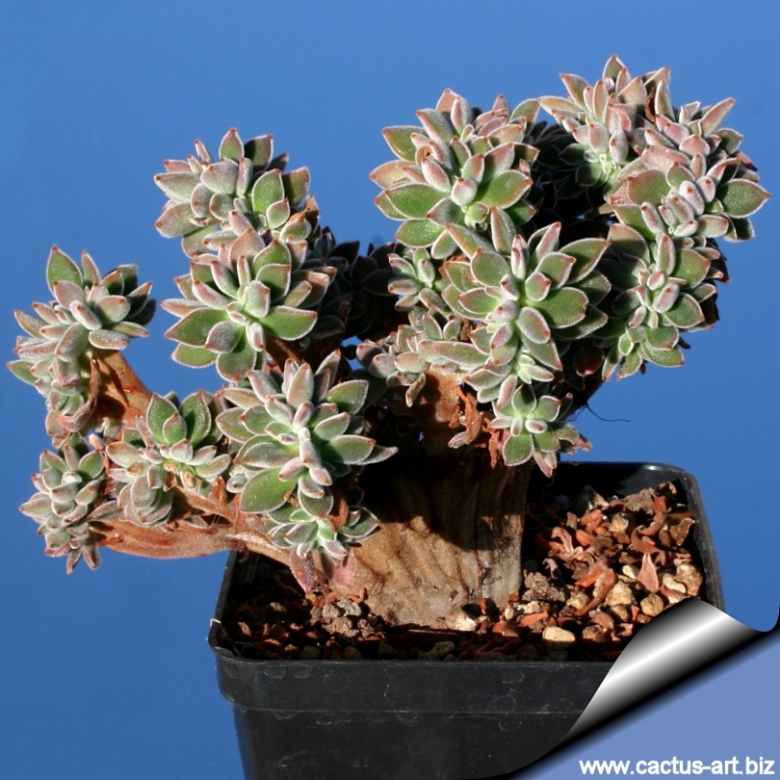
Echeveria coccinea f. cristata Photo by: Cactus Art
(San Bartolo Co. Hidalgo, Mexico) Great succulent with attractive very fuzzy leaves that feel to the touch like a cross between felt and velvet.
Origin and Habitat: Mexico (Hidalgo)
Synonyms:
See all synonyms of Echeveria coccinea
back
Accepted name in llifle Database:Echeveria coccinea f. cristataAccepted name in llifle Database:Echeveria coccinea (Cav.) DC.Prodr. [A. P. de Candolle] 3: 401. 1828 [mid Mar 1828] (see also: Rose, J.N. Sep 1903. Bull. New York Bot. Gard. 3: 5. )Synonymy: 2
back
Description: The Echeveria coccineaSN|13290]]SN|13290]] is a succulent rosette forming shrub, up to 60 cm tall or more that tends to branch at base. Upright at first, its stems become prostrate and root into the soil to form a spreading mound. The plant is soft-pubescent except for the inside of the flowers. The species is somehow variable in habitat and in cultivation too, comparable plants labelled E. coccinea vary considerably in stem and leaf shape depending on clone and growing condition.
Stems: Sparsely branching, 0.5-2 cm in diameter greyish or reddish brown, finely grey-pubescent like the rest of the plant.
Aerial roots: This species produces lots of thin hair-like aerial roots from the older part of the stem.
Leaves: 3-12 long,2-4 cm wide, in rosettes, and alternate and scattered on the flowering stems, oblanceolate to obovate-spatulate, narrow, tapered, upper face concave, soft dark green often redden velvety with a covered in fine silvery fuzz giving the leaves a blue-green colour.
Rosettes: Open, 5-20 cm in diameter.
Flowers: Abundant, in axillary long leafy simple spike inflorescence about 35-70 cm tall. Scarlet or reddish/yellow outside, yellow within. The flowers have a 5-parted corolla not longer than the spreading calyx. Sepals ascending to widely spreading, 13-15 mm long, calyx scarlet, sharply pentagonal 9-15 mm long, 8-9 mm in diameter at the base and 7-10 mm in diameter at the mouth.
Pedicel 2 mm long They last well when cut.
Blooming season: Flowers in spring.
Remarks: The rare crested form produces magnificent, fun shaped silvery, leaf rosettes at the ends of its reddish-brow velvety branches and seems to to change in and out of its crested mode during the years.
Subspecies, varieties, forms and cultivars of plants belonging to the Echeveria coccinea group
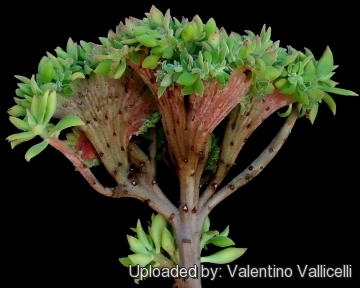 Echeveria coccinea f. cristata Photo by: Valentino Vallicelli
Echeveria coccinea f. cristata Photo by: Valentino Vallicelli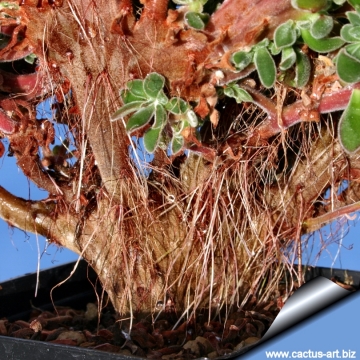 Echeveria coccinea f. cristata Photo by: Cactus Art
Echeveria coccinea f. cristata Photo by: Cactus Art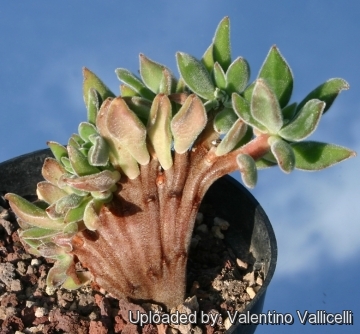 Echeveria coccinea f. cristata Photo by: Valentino Vallicelli
Echeveria coccinea f. cristata Photo by: Valentino Vallicelli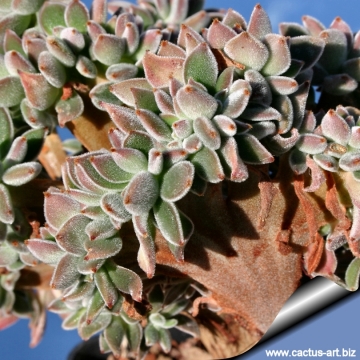 Echeveria coccinea f. cristata Photo by: Cactus Art
Echeveria coccinea f. cristata Photo by: Cactus Art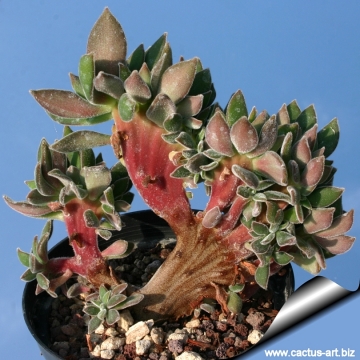 Echeveria coccinea f. cristata Photo by: Cactus Art
Echeveria coccinea f. cristata Photo by: Cactus Art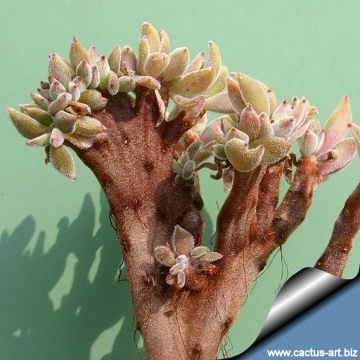 Echeveria coccinea f. cristata Photo by: Cactus Art
Echeveria coccinea f. cristata Photo by: Cactus Art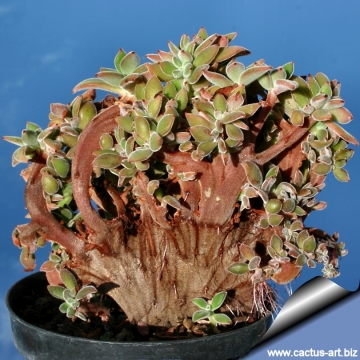 Echeveria coccinea f. cristata Photo by: Cactus Art
Echeveria coccinea f. cristata Photo by: Cactus Art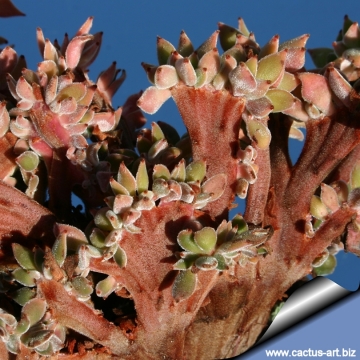 Echeveria coccinea f. cristata Photo by: Cactus Art
Echeveria coccinea f. cristata Photo by: Cactus ArtCultivation and Propagation: Echeveria are easily grown succulents that can tolerate sun, shade, moist soils, dry soils, but look their best only when given adequate light levels and water, and ideally should be grown outdoors in full sun. Generally speaking, the more light a plant gets the better it will display its colours and shape. Bright light is required to prevent "stretching" of Echeverias ("stretching" occurs when a moderately fast growing plant such as an Echeveria, is grown in dim light or over-fertilized, which causes overly lush growth that contributes to weak, pallid plants). However, when moving plants from lower light conditions into full sun, be wary of sun scorch resulting from too rapid a transition into intense summer sunlight, most easily avoided by ensuring plants are well-watered before moving them on a cloudy day. Echeveria are able to tolerate extended dry periods and survive drought without the need for watering, but they will grow stronger if they receive adequate moisture during their growing season, but never allowing the plant to remain waterlogged (root rot sensitive). For this reason, it is essential in cultivation to use a very porous soil, which will allow quick drainage. Avoid overhead watering under humid conditions, especially during winter. Echeveria are shallow rooted plants, and therefore benefit from good levels of organic matter in the soil. Give it enough root space for optimum growth. Slow release fertilisers with a low to moderate nitrogen content incorporated into the potting mix are usually adequate for the spring and summer growing seasons of Echeveria, and additional fertiliser applications would not normally be required until spring. Good air movement is important for minimising pest and disease risks, and avoiding excessive humidity in cool winter conditions is important to successfully growing Echeveria in the nursery environment. Can tolerate light frosts. however, the ideal temperature range during the summer growing season is 5-25°C, with the cooler autumn temperatures tending to make their foliage colours become more intense than those of the active summer growing season. Aphids like this plant (and all flowering Echeverias).
Crested growth: Unlike 'monstrose' varieties of plants, where the variation from normal growth is due to genetic mutation, crested growth can occur on normal plants. Sometimes it's due to variances in light intensity, or damage, but generally the causes are unknown. A crested plant may have some areas growing normally, and a cresting plant that looks like a brain, may revert to normal growth for no apparent reason. If you have any of the crested part left you need to remove the normal growth and leave the crested part behind this will need to be done regularly.
Propagation: It is easily propagated by cuttings in the spring. When the stem becomes too tall, just cut the top rosette with a piece of stem and plant it. It will soon take root, while the plant left with just the stem will soon grow new buds that can be in turn used for propagation. Time to take cuttings: April to July. It may also propagated by leaf propagation. If the plant is repotted some of the bottom leaves can be removed, in order to attempt propagation. However some of the cuttings will dry out without producing a plantlet. Echeveria coccinea also forms a good stock for dwarf-growing species.


















